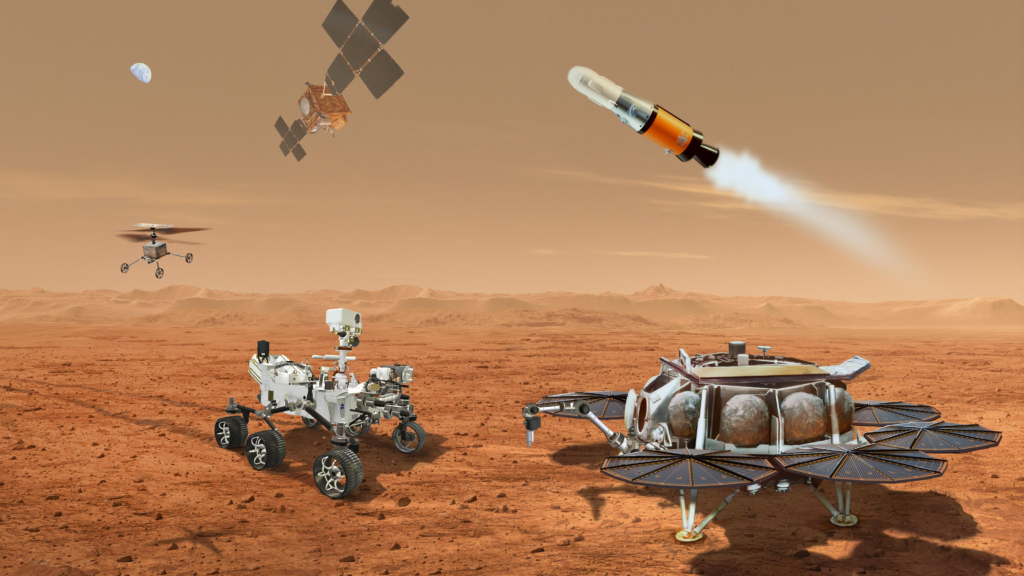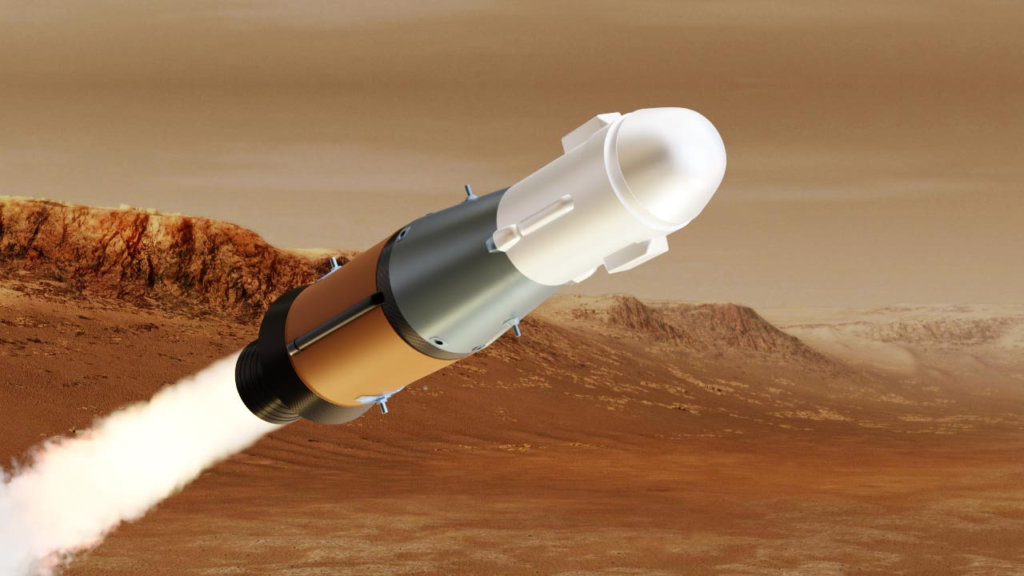
NASA’s Updated Plan To Retrieve Mars Samples By 2033
There is so much we don’t know about the Universe we live in and even our own solar system. Over half a century ago humans managed to step foot on the Moon and return samples to Earth. These same samples are still studied today and provide a large host of information on the Moon and additional information. For a while now NASA has been working on a way to send back samples from Mars.
Specifically, the agency just released an updated strategy on exactly how they plan to get the samples 100 of millions of miles away back to Earth. In this case, the Perseverance rover will take samples to a lander, so a robotic arm provided by the ESA can load them into an ascent vehicle. An additional two Mars helicopters will act as backups with a targeted return in 2033.
Over the past few years, we have watched NASA make progress on Mars. This has included landing new rovers, and even more exciting projects such as flying helicopters for the first time on a different planet. Now they have an even bigger challenge ahead of them. Here I will go more in-depth into the exact plan NASA released, what to expect in the future, and how these samples will be returned.
Updated Plan

Just yesterday NASA tweeted saying, “Here’s our updated plan to bring Mars samples to Earth: The @NASAPersevere rover will take samples to a lander, so a robotic arm provided by @ESA can load them into an ascent vehicle. Two Mars helicopters will act as back-ups. Targeting return in 2033.” More specifically, NASA has finished the system requirements review for its Mars Sample Return Program, which is nearing completion of the conceptual design phase. During this phase, the program team evaluated and refined the architecture to return the scientifically selected samples, which are currently in the collection process by NASA’s Perseverance rover in the Red Planet’s Jezero Crater.
The architecture for the campaign, which includes contributions from the European Space Agency (ESA), is expected to reduce the complexity of future missions and increase the probability of success. “The conceptual design phase is when every facet of a mission plan gets put under a microscope,” said Thomas Zurbuchen, associate administrator for science at NASA Headquarters in Washington. “There are some significant and advantageous changes to the plan, which can be directly attributed to Perseverance’s recent successes at Jezero and the amazing performance of our Mars helicopter.” This advanced mission architecture takes into consideration a recently updated analysis of Perseverance’s expected longevity. Perseverance will be the primary means of transporting samples to NASA’s Sample Retrieval Lander carrying the Mars Ascent Vehicle and ESA’s Sample Transfer Arm.
As such, the Mars Sample Return campaign will no longer include the Sample Fetch Rover or its associated second lander. The Sample Retrieval Lander will include two sample recovery helicopters, based on the design of the Ingenuity helicopter, which has performed 29 flights at Mars and survived over a year beyond its original planned lifetime. The helicopters will provide a secondary capability to retrieve samples cached on the surface of Mars. The ESA Earth Return Orbiter and its NASA-provided Capture, Containment, and Return System remain vital elements of the program architecture.
With planned launch dates for the Earth Return Orbiter and Sample Retrieval Lander in fall 2027 and summer 2028, respectively, the samples are expected to arrive on Earth in 2033. With its architecture solidified during this conceptual design phase, the program is expected to move into its preliminary design phase this October. In this phase, expected to last about 12 months, the program will complete technology development and create engineering prototypes of the major mission components. This refined concept for the Mars Sample Return campaign was presented to the delegates from the 22 participating states of Europe’s space exploration program, Terrae Novae, in May. At their next meeting in September, the states will consider the discontinuation of the development of the Sample Fetch Rover.
“ESA is continuing at full speed the development of both the Earth Return Orbiter that will make the historic round-trip from Earth to Mars and back again; and the Sample Transfer Arm that will robotically place the sample tubes aboard the Orbiting Sample Container before its launch from the surface of the Red Planet,” said David Parker, ESA director of Human and Robotic Exploration. The respective contributions to the campaign are contingent upon available funding from the U.S. and ESA participating states. More formalized agreements between the two agencies will be established in the next year. “Working together on historic endeavors like Mars Sample Return not only provides invaluable data about our place in the universe but brings us closer together right here on Earth,” said Zurbuchen.
The first step in the Mars Sample Return Campaign is already in progress. Since it landed at Jezero Crater Feb. 18, 2021, the Perseverance rover has collected 11 scientifically-compelling rock core samples and one atmospheric sample. Bringing Mars samples to Earth would allow scientists across the world to examine the specimens using sophisticated instruments too large and too complex to send to Mars and would enable future generations to study them. Curating the samples on Earth would also allow the science community to test new theories and models as they are developed, much as the Apollo samples returned from the Moon have done for decades. This strategic NASA and ESA partnership will fulfill a solar system exploration goal, a high priority since the 1970s and in the last three National Academy of Sciences Planetary Science Decadal Surveys.
Mars Samples

While some of the plans have changed in how exactly the agencies plan to retrieve the samples, one part that has stayed the same is the Mars Ascent Vehicle. Not very long ago NASA awarded a contract to Lockheed Martin Space of Littleton, Colorado, to build the Mars Ascent Vehicle (MAV), a small, lightweight rocket to launch rock, sediment, and atmospheric samples from the surface of the Red Planet. The award brings NASA a step closer to the first robotic round-trip to bring samples safely to Earth through the Mars Sample Return program. At the time of this announcement, NASA’s Administrator said, “This groundbreaking endeavor is destined to inspire the world when the first robotic round-trip mission retrieves a sample from another planet – a significant step that will ultimately help send the first astronauts to Mars”. “America’s investment in our Mars Sample Return program will fulfill a top priority planetary science goal and demonstrate our commitment to global partnerships, ensuring NASA remains a leader in exploration and discovery.”
Set to become the first rocket fired off another planet, the MAV is a crucial part of a campaign to retrieve samples collected by NASA’s Perseverance rover and deliver them to Earth for advanced study. NASA’s Sample Retrieval Lander, another important part of the campaign, would carry the MAV to Mars’ surface, landing near or in Jezero Crater to gather the samples cached by Perseverance. The samples would be returned to the lander, which would serve as the launch platform for the MAV. With the sample container secured, the MAV would then launch. Once it reaches Mars orbit, the container would be captured by an ESA (European Space Agency) Earth Return Orbiter spacecraft outfitted with NASA’s Capture, Containment, and Return System payload. The spacecraft would bring the samples to Earth safely and securely in the early- to mid-2030s. “Committing to the Mars Ascent Vehicle represents an early and concrete step to hammer out the details of this ambitious project not just to land on Mars, but to take off from it,” said Thomas Zurbuchen, the associate administrator for science at NASA Headquarters in Washington. “We are nearing the end of the conceptual phase for this Mars Sample Return mission, and the pieces are coming together to bring home the first samples from another planet. Once on Earth, they can be studied by state-of-the-art tools too complex to transport into space.”
Returning a sample is complicated, and MAV faces some complex development challenges. It must be robust enough to withstand the harsh Mars environment and adaptable enough to work with multiple spacecraft. It also must be small enough to fit inside the Sample Retrieval Lander. The Sample Retrieval Lander is planned for launch no earlier than 2026 from NASA’s Kennedy Space Center in Florida. This is just one of the steps in this complex process to send these invaluable samples to Earth.
Conclusion
Mars is a few hundred million miles away from Earth. This being said, the samples collected on the surface if sent to Earth could provide a massive amount of information on not only the planet, but much more. NASA just recently updated the plan to retrieve these samples with a return date of 2033. We will have to wait and see how it progresses and the impact it has on the space industry.
